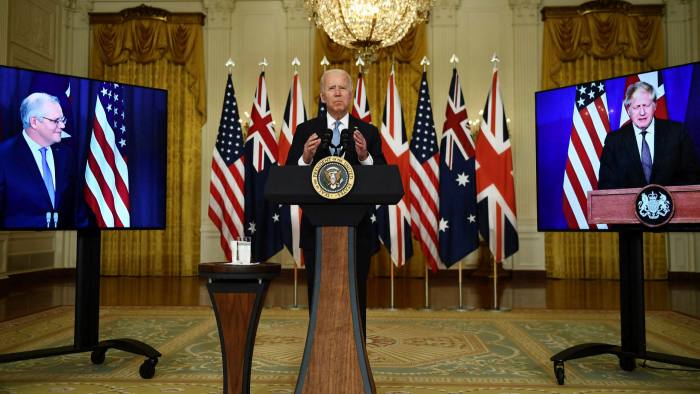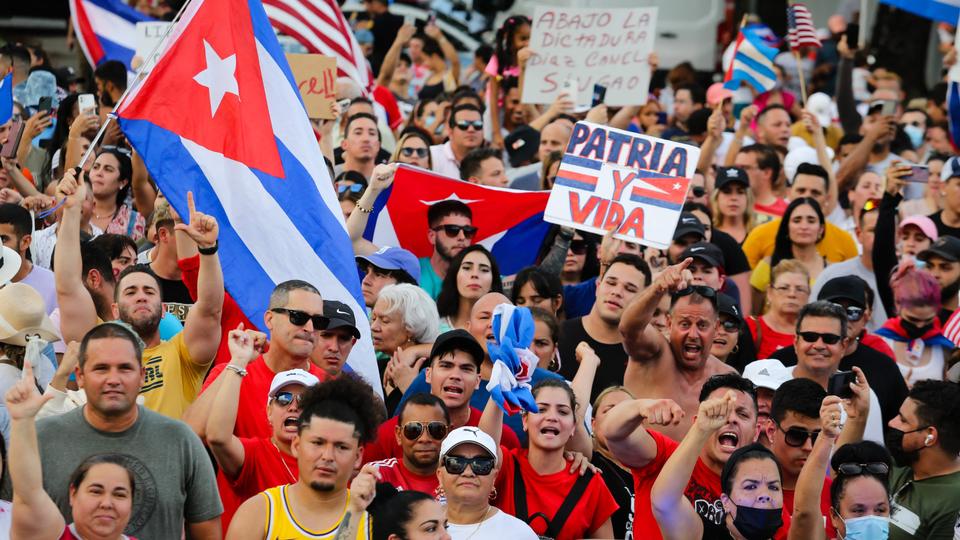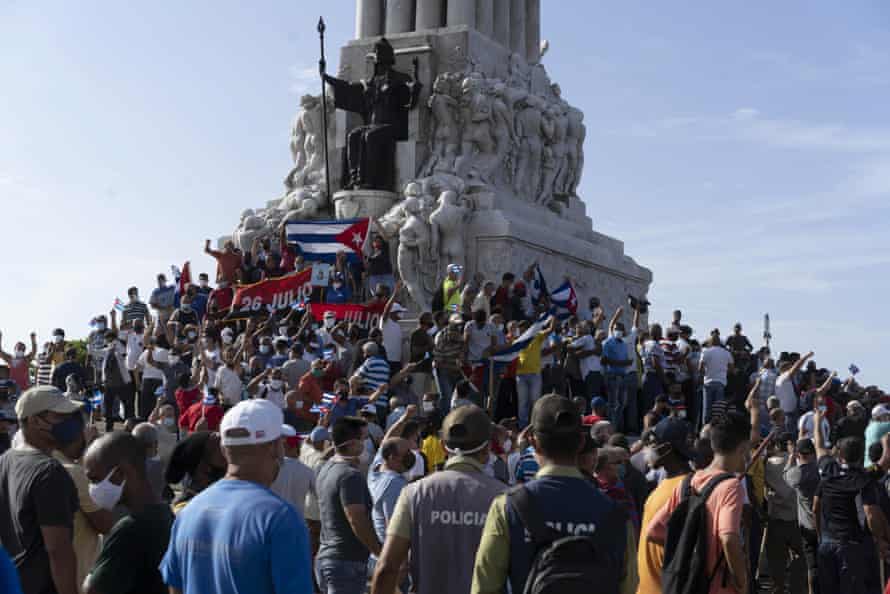segunda-feira, 19 de fevereiro de 2024
AGORA VOCÊ NOS ENCONTRA AQUI:
domingo, 20 de março de 2022
segunda-feira, 21 de fevereiro de 2022

Esta guerra fratricida é benéfica apenas para os magnatas do capital financeiro. No mundo contemporâneo, os predadores capitalistas entendem que qualquer guerra entre potências nucleares é imprevisível em termos de consequências e apresenta uma ameaça real de destruição da humanidade, usando as pilhas de armas letais acumuladas ao longo dos anos. Portanto, imperialistas sanguessugas se beneficiam de conflitos locais nos quais uma ditadura abertamente chauvinista e terrorista do próprio capital financeiro, isto é, o fascismo, pode ser usada.
Grécia: Breve visão geral da situação em 2022
Breve visão geral da situação na Grécia em 2022
M. Santaskidis, KED (Grécia)
 |
| A presidente grega Katerina Sakellaropoulou em frente a um muro na fronteira, significando ao mais alto nível a política anti-migrante do estado" |
A Grécia, com seu atual governo neoliberal eleito com uma retórica racista, anti-imigração e medo, chegou a um momento peculiar, onde após uma década de austeridade e turbulência, políticas e práticas semelhantes do Estado não estão sendo contestadas. A nova legislação antilaboral, a normalização de um ambiente de trabalho com baixos salários e altas jornadas de trabalho, novos tipos de emprego – prejudiciais para os trabalhadores – o aumento dos aluguéis e dos preços em geral, são as novas condições de vida em que as pessoas são forçados a lutar pela sobrevivência.
sexta-feira, 4 de fevereiro de 2022
ARGENTINA: Alberto con FMI, Cristina contra

Publicamos abaixo a análise de nossa corrente irmã argentina TMB sobre a crise dentro do governo do partido chamado Frente de Todos, devido as negociações entre o presidente Alberto Fernandez e o FMI, criticadas por nós aqui. É interessante destacar que na Argentina ocorre um fenômeno simetricamente inverso à Honduras, mesmo levando em consideração todas as diferenças entre as duas conjunturas e entre as nações. Em Honduras, ocorreu uma rebelião parlamentar pro-imperialista de uma fração de parlamentares do partido Libre contra a presidente recém eleita pelo Libre, Xiomara Castro (ver aqui). Os rebelados se aliaram com a oposição de direita, ao partido do ex-presidente JOH, contra a presidente para tentar impor o então dirigente parlamentar do Libre como mandatário do Congresso. Foram expulsos do Libre. Na Argentina, a rebelião tem um signo de esquerda. A fração kichnerista do partido Frente de Todos, do presidente Alberto Fernandez, se rebelou contra o acordo com o FMI e a aproximação da Argentina com os EUA, movimento de Fernandez que conta com as simpatias de parlamentares da oposição de direita, ligados ao ex-presidente Macri.
domingo, 30 de janeiro de 2022
Honduras
Como evitar um novo golpe?
O que a primeira tentativa de golpe nos ensina desde a cooptação pela própria liderança parlamentar do próprio Libre e foi desvelada com a mobilização popular
Declaração do Comitê de Ligação para a Quarta Internacional, uma organização internacional de trabalhadores comunistas
Honduras (2009), Líbia (2011), Paraguai (2012), Ucrânia (2014), Brasil (2016), Bolívia (2019)...? Os golpes de estado voltaram com toda a força para se tornar moda entre os mecanismos dos Estados Unidos para não perder o controle do planeta diante de um bloco de países inimigos, como China, Rússia, Irã, Venezuela, Cuba, .. As velhas justificativas também voltaram, a suposta luta contra a corrupção, o comunismo, a “guerra às drogas”. O objetivo também permanece, de impor governos fantoches contra a vontade da maioria popular e continuar a saquear o sul do continente como se fosse seu quintal.
Que a OTAN tire suas mãos da Ucrânia!

O atual confronto pela Ucrânia é consequência do impulso fundamental do imperialismo dos Estados Unidos, como imperialismo hegemônico mundial, de reconquistar os dois principais países do mundo onde o capitalismo foi derrubado durante o século XX, Rússia e China, para o seu capitalismo.
sexta-feira, 28 de janeiro de 2022
Iêmen
Pela derrota dos EUA, Israel e da Monarquia saudita!
Por Christian RomeroNo dia 21 de janeiro, em uma atitude cruel e covarde, ataques aéreos liderados pela Arábia Saudita deixaram mais de 70 mortos, pelo menos três crianças e 200 feridos.
A quase totalidade dos mortos eram prisioneiros indefesos na cidade de Saada, cidade localizada ao norte do Iêmen, perto da fronteira saudita. Mais a sul na cidade portuária de Hodeidah, as crianças morreram quando os ataques aéreos da coligação liderada pela Arábia Saudita atingiram uma instalação de telecomunicações enquanto brincavam nas proximidades, disse Save the Children. O Iêmen também sofreu um apagão na internet em todo o país. A Arábia Saudita lidera uma coalizão militar apoiada pelos EUA e por Israel, contra os guerrilheiros houthies, apoiados pelo Irã e pelo Hezbollah.
sexta-feira, 21 de janeiro de 2022
Coletes Amarelos no Cazaquistão?
Humberto Rodrigues
Era melhor acreditar que no Cazaquistão ocorreu o início de genuína revolução contra tudo e contra todos. Uma revolução que foi desencadeada pela luta contra a inflação dos combustíveis, os oligarcas, os monopólios imperialistas e desgraçadamente abortada pela intervenção dos tanques russos (como ocorria durante a primeira Guerra Fria 1945-1991).
quarta-feira, 19 de janeiro de 2022
Lenin e Trotsky sobre o assassinato de Rosa e Karl
 |
| Lenin, na inauguração do monumento a Rosa Luxemburgo e Karl Liebknecht no primeiro aniversário de seus assassinatos, Praça de Petrogrado, 1920. |
“Hoje a burguesia e os traidores sociais suspiram de alegria em Berlim; conseguiram-no assassinando Karl Liebknecht e Rosa Luxemburgo. Ebert e Scheidemann, que durante quatro anos levaram os trabalhadores ao massacre por causa da pilhagem da I Guerra Mundial, agora assumiram o papel de massacrar os líderes proletários. O exemplo da Revolução Alemã mostra que a "democracia" é apenas uma camuflagem para o roubo burguês e a violência mais selvagem. Morte aos açougueiros‼”
terça-feira, 18 de janeiro de 2022
Sistema Mundial Capitalista perto da morte
 |
| Conselho de Governadores do Sistema da Reserva Federal (EUA) Gráfico mostrando o aumento do volume monetário do Banco Federal dos Estados Unidos de 1959 a agosto de 2021 |
segunda-feira, 17 de janeiro de 2022
O NED no Cazaquistão
Por Jeremy Kuzmarov, Revista de ação secreta.

Em 2 de janeiro, protestos eclodiram na cidade de Zhanaozen, no oeste do Cazaquistão, que desde então se espalharam por todo o país. Mais de 160 pessoas foram mortas, incluindo pelo menos 18 policiais, com centenas de feridos.
O New York Times e outros grandes meios de comunicação retrataram a violência como resultado da duplicação dos preços dos combustíveis e da infelicidade com o autoritarismo político e a corrupção .
Rosa, Liebknecht e Lenin
O legado dos 3Ls: Luxemburgo, Liebknecht e Lenin
Humberto Rodrigues
"A ordem reina em Berlim!... Ah! Estúpidos e insensatos carrascos! A revolução levantará sua cabeça novamente amanhã e, para o horror estampado em vossos rostos, anunciará com todas suas trombetas: ‘Eu fui. Eu sou. Eu serei!"
Últimas palavras escritas por Rosa.
 |
| Luxemburgo, Liebknecht, Lenin. Ninguém será esquecido! Levante-se e Resista! |
sábado, 15 de janeiro de 2022
Cazaquistão - Declaração Internacional
Derrota de mais uma Revolução Colorida
Declaração internacional ampliada em seu conteúdo e em assinaturas pela adesão de novos camaradas e organizações da Austrália, Grécia, Coréia do Sul, Grã Bretanha, Turquia, Argentina, Bangladesh e Brasil.
Uma revolução colorida é uma mudança de regime em favor do imperialismo. Consideramos que o recente motim de 10 dias armado contra o governo do Cazaquistão como uma das estratégias para expandir o poder do imperialismo da OTAN centrado nos EUA. Após o colapso da União Soviética e o renascimento do capitalismo, a OTAN está se movendo em direção ao seu objetivo final, a Rússia, subjugando países próximos à Europa Ocidental um após o outro. O objetivo da operação não é apenas reviver o capitalismo, mas estabelecer um regime pró-imperialista obediente para maximizar os superlucros.
terça-feira, 11 de janeiro de 2022
O RCEP e a Economia Mundial
Fabio Sobral *

O acordo do RCEP (Regional Comprehensive Economic Partnership), que começou a funcionar em primeiro de janeiro de 2022, criou no Oriente a maior área de livre comércio mundial. Haverá alterações profundas na configuração dos setores produtivos, comerciais, financeiros e militares.
O acordo do RCEP não foi feito para a China aproveitar sua imensa capacidade industrial e esmagar a indústria dos outros países. A Índia acusou a China de ter esse objetivo e recusou-se a participar. À primeira vista parece uma conclusão acertada, mas o que está nos fundamentos desse acordo?
As lições do Cazaquistão

O Cazaquistão sofre uma revolta interna de grandes proporções. Uma revolta iniciada contra a elevação dos preços dos combustíveis.
A revolta evoluiu para confrontos sangrentos nas ruas das principais cidades. O presidente revogou os aumentos e pediu a renúncia do primeiro ministro. Mesmo assim, os manifestantes aumentaram seus ataques a prédios públicos e a forças policiais, quase como uma repetição do método utilizado para derrubar o governo Yanukóvych na Ucrânia, no que ficou conhecido como revolta da Praça Maidan.
terça-feira, 4 de janeiro de 2022
Há um ano do levante trumpista
Republicamos este apelo à ação emitido pela Frente Unica por um Partido Trabalhista de Massa e já apoiado por organizações de quatro continentes. Estamos assinando e conclamamos todas as organizações e indivíduos da classe trabalhadora internacionalmente a endossar e compartilhar este apelo na construção até 6 de janeiro. Novas adesões ou notícias de outras ações em 6 de janeiro podem ser enviados para labormedia1@gmail.com
segunda-feira, 3 de janeiro de 2022
Não Olhe para Cima
Finalmente assisti ao filme Não olhe para cima; e trago, aqui, minhas primeiras impressões. Embora primeiras impressões nunca sejam completas, penso que isso não quer dizer que sejam insignificantes.
Em primeiro lugar, gostei. O roteiro de Adam McKay e David Sirota prende do início ao fim. A trama gira em torno de Kate Dibiasky (Jennifer Lawrence) e Randall Mindy (Leonardo DiCaprio), astrônomos que fazem a descoberta de um cometa que está em rota de colisão com a Terra. Com a ajuda do doutor Teddy Oglethorpe (Rob Morgan), Kate e Randall vão à Presidente dos Estados Unidos (EUA), Janie Orlean (Meryl Streep), e a seu filho, Jason Orlean (Jonah Hill), Chefe de Gabinete, que, inicialmente, mostram-se indiferentes diante do desastre iminente. Como é comum à política burguesa, só se interessam em buscar uma solução quando precisam capitalizar politicamente o caso. A apenas seis meses do impacto que irá destruir a civilização e boa parte da diversidade biológica, trava-se uma batalha da verdade científica contra os interesses políticos da extrema direita, a lógica destrutiva do capitalismo e a decadência da sociabilidade burguesa.
quinta-feira, 16 de dezembro de 2021
A dialética da nova guerra fria
Leon Carlos e Humberto Rodrigues
quarta-feira, 15 de dezembro de 2021
O fantasma da revolução cubana e um "maldito" panfleto da LC

quinta-feira, 9 de dezembro de 2021
Comunicado
A Frente Comunista dos Trabalhadores (FCT) retomou o nome de Liga Comunista (LC).
Primeiro, pela unidade programática maior alcançada entre seus militantes o que descaracteriza o caráter de frente.
Segundo, o nome Liga Comunista remete à tradição da primeira organização política de Marx e Engels e ao primeiro coletivo trotskista (bolchevique-leninista) do Brasil que participou da fundação da IV Internacional em 1938.
Terceiro, identifica-se com os fundamentos programáticos expressos no Manifesto do Partido Comunista, nos quatro primeiros congressos da Internacional Comunista e no Programa de Transição.
sábado, 4 de dezembro de 2021
Fome, Lula e o Golpe de 2022
E o dever dos comunistas de disputar a consciência do eleitorado lulista contra a política kamikase do lulismo
Humberto Rodrigues
O preço do milho disparou. Os preços mundiais dos alimentos bateram um novo recorde, atingindo níveis que não se viam desde 2011, o índice de preços dos alimentos foi em média 134,4 pontos no mês passado, 1,2 % a mais do que em outubro, segundo a Organização das Nações Unidas para Alimentação e Agricultura (FAO).
Fidel, Allende, Revolução, Golpes e Contrar-Revolução na América Latina
Entrevista histórica dupla com Allende e Fidel, ao jornalista chileno e assessor pessoal de Allende, Augusto Olivares, acontecida em novembro de 1971. Aqui reproduzida pela TV pública argentina que recebeu o nome de "El Dialogo de America". A conversa foi realizada nos jardins do palácio presidencial, onde temas como "A via chilena para o socialismo" e os obstáculos para sua realização foram refletidos pelos dois estadistas.
https://www.youtube.com/watch?v=BLoIwfSV0PY
terça-feira, 23 de novembro de 2021
Plenária Nacional pelo Fora Bolsonaro - Lula presidente
Nos dias 06 e 07 de novembro, se realizou em São Paulo a Plenária Nacional Fora Bolsonaro – Lula Presidente. Foi convocada por um esforço conjunto do Partido da Causa Operaria, do Partido Comunista do Povo Brasileiro e por nossa organização, a Frente Comunista dos Trabalhadores - Comitê de Ligação Quarta Internacional. Com a predominância da militância do PCO, a Plenária Nacional teve aderência de vários movimentos sociais, sindicatos e ativistas, movimentos indígenas, atraindo, inclusive, setores do PT e do movimento sindical e popular descontentes com a orientação política de enterrar a luta de ruas para começar a campanha eleitoral.
quarta-feira, 17 de novembro de 2021
Argentina
Por Christian Romero e Humberto Rodrigues.
sábado, 13 de novembro de 2021
Manifesto por Cuba contra os EUA
O imperialismo dos EUA está promovendo uma mobilização da direita neste 15 de novembro em Cuba, pela derrubada do planejamento econômico e a restauração em grande escala do capitalismo. A burguesia gusana é um componente orgânico do imperialismo e encabeça essa campanha criminosa contra o Estado operário cubano.
quarta-feira, 10 de novembro de 2021
VÍDEO: EM DEFESA DE CUBA, CONTRA OS GUSANOS E OS EUA
quinta-feira, 4 de novembro de 2021
OS DESEMPREGADOS FAZEM PARTE DO PROLETARIADO?
Frederico Costa*
Foi usual, nas décadas de 1980 e 1990 do século passado, a afirmação de que o proletariado teria desaparecido. Uma tese bastante comum afirmava que os desempregados não são proletários e que novas tecnologias tendem a eliminar o próprio trabalho criando uma população crescente de “marginalizados” e “excluídos”. Além disso, outras teses excluíam do proletariado um conjunto de setores sociais: “empregados”, “trabalhadores por conta própria”, desempregados”, “pobres” etc.
NÃO AO 15N GUSANO! - CLQI
Rechaçar à mobilização Gusana de 15/11, que faz parte da guerra híbrida do imperialismo contra Cuba!
Pela defesa incondicional do estado operário cubano!
Declaração do CLQI
O imperialismo dos EUA está promovendo através do uso de técnicas híbridas de guerra, uma mobilização contra-revolucionária em 15 de novembro, em Cuba. Essa manifestação faz parte de sua campanha criminosa contra o Estado operário desde a década de 1960. A burguesia cubana, expropriada e obrigada a fugir para os EUA após o giro anticapitalista da revolução, em 1961, tornou-se um componente orgânico do imperialismo.
domingo, 26 de setembro de 2021
AUKUS - CLQI
Nova ameaça de guerra nuclear imperialista em meio ao perigo climático!
 Conferência de imprensa de lançamento da AUKUS, 15 de setembro
Conferência de imprensa de lançamento da AUKUS, 15 de setembroLogo após os EUA reduzirem suas perdas no Afeganistão em agosto, vem a formação do AUKUS, uma nova aliança trilateral entre os Estados Unidos, Grã-Bretanha e Austrália, com o objetivo transparente de atingir a China na região da Ásia-Pacífico. Isso traz uma potente ameaça de guerra para o futuro, a fim de tentar preservar o domínio mundial dos Estados Unidos, e desmascara completamente a extrema farsa que está sendo defendida por Biden et al sobre fazer algo a respeito da mudança climática. De fato, eles preferem uma boa dose de chantagem nuclear agressiva com a ameaça de um holocausto nuclear. Assim como o execrável líder imperialista do Partido Trabalhista britânico, Starmer, que saudou isso na Câmara dos Comuns e parecia ainda mais entusiasmado com isso do que o próprio Boris Johnson. Outro entusiasmado para "lutar pela sobrevivência humana e ecológica".
quinta-feira, 23 de setembro de 2021
Partido Judiciário e Golpismo
Humberto Rodrigues
O Supremo Tribunal Federal tornou-se o Comitê Central do Partido Judiciário e principal trincheira dos golpistas de 2016 que articulam a 3ª via entre Lula e Bolsonaro. O Judiciário é um dos partidos não orgânicos decisivos na atual conjuntura. Gramsci pensava que em determinadas conjunturas, notadamente durante as crises políticas, naquelas em que os representantes tradicionais e oficiais das classes e/ou frações se encontram em crise de representação e de hegemonia, outras entidades, formais ou informais, na sociedade ou mesmo de setores do Estado, assumem o papel de “organização da sociedade” e de “direção político/ideológica”, notavelmente de grupos específicos. O italiano também observou, que certas instituições políticas sediadas na chamada “sociedade civil” por vezes fariam a função e o papel dos partidos políticos formais como “intelectuais orgânicos” de determinadas classes ou frações de classes sociais. Para Gramsci, o Estado é “ampliado”, articulando os aparatos do Estado e as organizações da “sociedade civil”.
Frente Ampla de Lula prepara uma nova derrota
Leon Carlos e Humberto Rodrigues
Setores burgueses de peso, como a Globo e políticos marginalizados da direita como FHC e Rodrigo Maia consideram Lula como mal menor. Apesar de alguns setores do capital, como os banqueiros terem obtido superlucros com o governo Bolsonaro, vários outras frações, que participam da ciranda rentista, mas tem o núcleo originário de seus negócios em outros ramos da economia, estão descendo ladeira abaixo em sua lucratividade.
sexta-feira, 17 de setembro de 2021
O fantasma do “terceiro período” ainda persegue setores da esquerda brasileira
Na história do movimento operário, o “terceiro período” significou uma orientação política desastrosa do stalinismo que expressou a degeneração da revolução socialista russa. De acordo com a estratégia da burocracia soviética, a luta de classes adotaria a seguinte trajetória: depois de uma primeira fase de ascenso revolucionário de 1919-1923 e de uma segunda etapa de estabilização relativa do capitalismo entre 1924-1927, a partir de 1928, abrir-se-ia um período de possibilidades revolucionárias imediatas. Tal visão arbitrária e inconsequente deteve-se em 1934, primeiro ano da ascensão do nazismo na Alemanha, e foi deixada no esquecimento pelos estrategistas stalinistas. Hoje, pouco se fala dessa aberração caiada de marxismo. No entanto, suas teses ainda se fazem presentes.
sexta-feira, 10 de setembro de 2021
Dossiê Afegão - Grupo Bolchevique da Coréia do Sul
sábado, 28 de agosto de 2021
Consequências da contrarrevolução na URSS
A destruição final na URSS, após 74 anos de existência, em agosto de 1991, foi a maior derrota da classe trabalhadora e do comunistas nos últimos 50 anos. É preciso reconhecer essa verdade e dizê-la por mais amarga que ela seja. Esse é um ponto de partida para compreender a realidade atual para os que querem modificá-la, para todo aquele que tenha como estratégia a luta pelo comunismo. As lições dessa derrota são tão ou mais importantes para o nosso tempo quanto as lições de outubro de 1917 e as das causas da degeneração burocrática nas décadas seguintes.
Vídeo: 30 anos da Contrarrevolução, Trotsky e Crise da Esquerda
 |
| Para acessar ao vídeo, clique aqui |
terça-feira, 24 de agosto de 2021
Fim da URSS e China
Uma análise da contrarrevolução na URSS e suas consequências acerca do caráter do Estado chinês
O presente documento faz parte da coletânea de textos acerca da Contrarrevolução na URSS que integrarão um livro homônimo que se encontra no prelo. Abaixo, publicamos uma das três partes que compõe a declaração do Comitê de Ligação pela IV Internacional acerca da Contrarrevolução na URSS, da Guerra no Afeganistão e uma polêmica sobre o caráter do Estado Chinês. Uma versão em inglês se encontra no site de nossos camaradas britânicos do Consistent Democrats: LCFI Statement: Soviet-bloc Counterrevolution Still Traumatises Humanity.
O colapso da URSS foi previsto por muito tempo, em linhas gerais, pelo movimento trotskista, embora os detalhes, processos e resultados tenham provado ser uma fonte de forte desacordo e divisão. Uma tradição trotskista que se destacou por fazer afirmações aparentemente robustas, mas na verdade problemáticas e, em última análise, falsas após ter analisado de forma única e correta o colapso da URSS e resistido até o fim, foram os camaradas da agora fragmentada International Bolshevik Tendency, IBT (doravante Tendência Bolchevique Internacional ou TBI). A TBI foi, uma tendência trotskista ostensivamente ortodoxa que emergiu de dentro dos espartaquistas no início dos anos 1980 e que afirmava ser a mais recente incorporação de uma continuidade da tradição revolucionária derivada deles.
EUA, Afeganistão e URSS
 |
| O então presidente dos EUA, Ronald Reagan recebe os Mujahideens na Casa Branca |
Além do aniversário do colapso soviético, a retirada das tropas dos EUA do Afeganistão levou ao colapso do regime fantoche pró-EUA de Ashraf Ghani no Afeganistão. O Afeganistão está ligado ao colapso contra-revolucionário da URSS. O financiamento maciço dos EUA para uma jihad contra o governo do Partido Democrático Popular do Afeganistão (PDPA), nacionalista de esquerda aliado a Moscou (PDPA), começou no final dos anos 1970, e quando a União Soviética interveio em dezembro de 1979 para impedir a derrubada do PDPA por esses contra-revolucionários, o Afeganistão tornou-se uma causa célebre do anticomunismo. Ronald Reagan e Margaret Thatcher se associaram publicamente aos mujahedin, os "guerreiros sagrados" que receberam armamentos de alta tecnologia como os mísseis Stinger para lutar contra o PDPA e a URSS.
Contrarrevolução segue traumatizando
O presente documento faz parte da coletânea de textos acerca da Contrarrevolução na URSS que integrarão um livro homônimo que se encontra no prelo. Abaixo, publicamos uma das três partes que compõe a declaração do Comitê de Ligação pela IV Internacional acerca da Contrarrevolução na URSS, da Guerra no Afeganistão e uma polêmica sobre o caráter do Estado Chinês. Uma versão em inglês se encontra no site de nossos camaradas britânicos do Consistent Democrats: LCFI Statement: Soviet-bloc Counterrevolution Still Traumatises Humanity
A Revolução Russa de Outubro foi o maior evento até agora na história da humanidade. Foi a primeira oportunidade para a humanidade começar a abolir o sistema capitalista cuja busca pelo lucro já havia levado ao pesadelo de milhões de trabalhadores sendo arrastados para massacrar uns aos outros em toda a Europa como as várias potências imperialistas lutaram entre si para dividir e redividir o mundo.
sábado, 21 de agosto de 2021
Não a privatização dos Correios!
segunda-feira, 26 de julho de 2021
Cuba, Haiti, Brasil, Para onde vão?
 |
| Para acessar vídeo do Debate clique aqui |
Para saber mais:
REGIME GOLPISTA E GOVERNO BOLSONARO AUMENTAM SOFRIMENTO DOS TRABALHADORES
 |
Fragmento de arroz e de feijão (bandinha), ossos de boi e pé de galinha: a dieta da fome |
A alta da inflação e o desemprego, próprios da crise capitalista, são acelerados pelo governo de extrema direita de Bolsonaro e seus apoiadores, pois, enquanto aumentam a inflação e o desemprego, crescem, também, a concentração de renda e os ataques aos direitos sociais da maioria da população.
domingo, 25 de julho de 2021
Borba Gato e o simbolismo da barbárie
Mário Maestri, Historiador
quarta-feira, 21 de julho de 2021
Fora o Imperialismo da América Latina, em Defesa de Cuba!
Não à ofensiva imperialista na América Latina, pela defesa incondicional do Estado operário cubano!
Declaração do Comitê de Ligação para a Quarta Internacional
1. A contra-ofensiva geopolítica dos EUA
Na mesma semana, dois eventos inéditos aconteceram no Caribe. Em primeiro lugar, houve o assassinato do presidente haitiano, Moïse, que gerou um caos social no país. Em seguida, houve protestos sincronizados em várias cidades de Cuba e dos Estados Unidos contra o governo cubano.
terça-feira, 20 de julho de 2021
Teoria - Dialética e Irracionalismo
Sávio Bastos - GPOSSHE (Original publicado aqui)
irracionalismo, como designação de uma tendência ou escola filosófica, é fundamentalmente a negação da existência de leis objetivas que regem os processos da natureza e as relações sociais dos homens, ou a negação da possibilidade de conhecê-las, sendo as leis objetivas aquelas que operam independentemente da vontade humana. Na linguagem de muitos dos filósofos, é a negação da possibilidade de conhecimento da essência da coisa-em-si, da lei mais íntima que rege aquilo que tem uma existência independente do homem e de sua apreensão pelo intelecto humano; o irracionalismo, assim, nega a possibilidade de apreensão e conhecimento das leis que regem os fenômenos, sejam os da natureza ou os da sociedade.
































